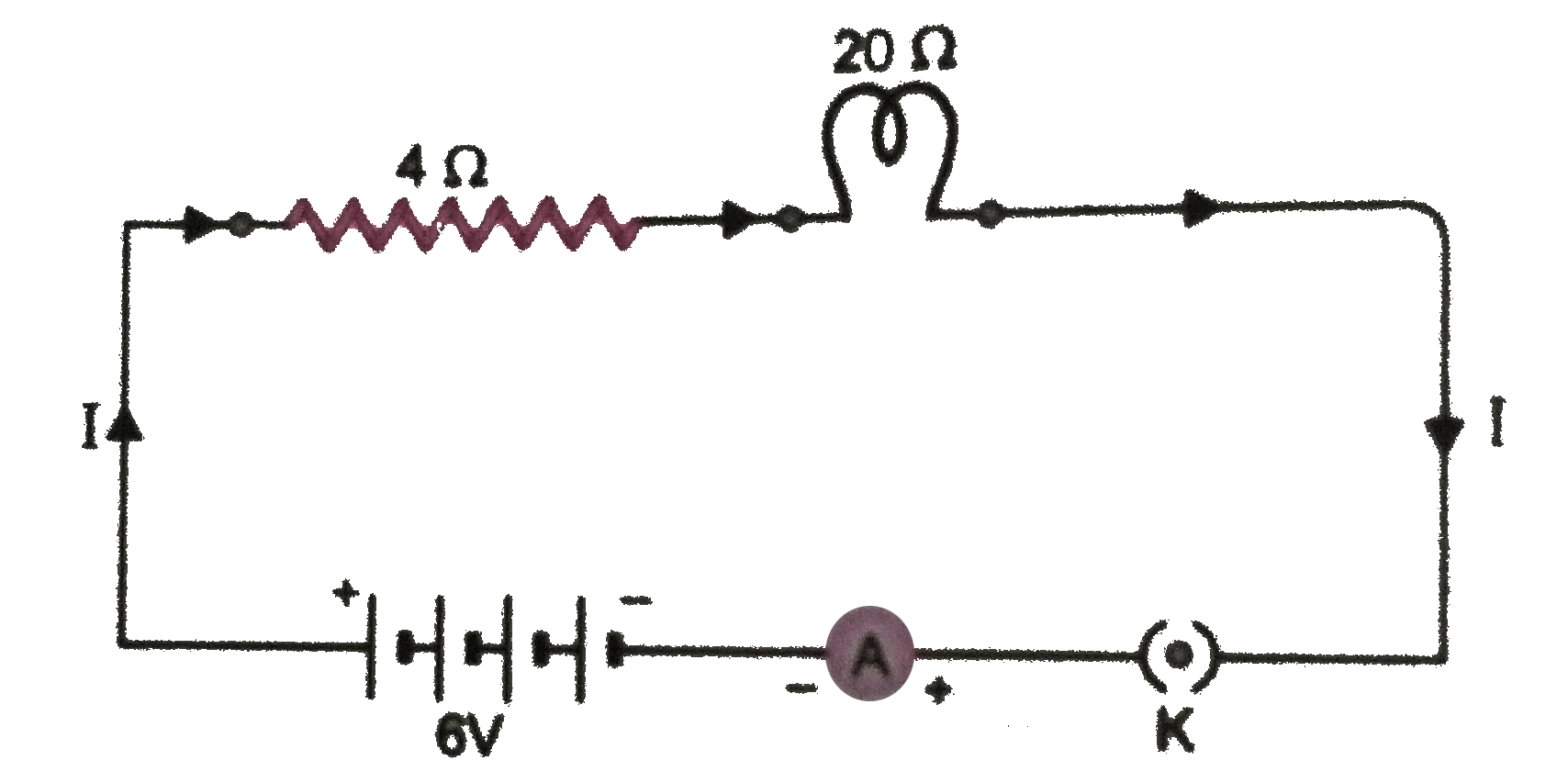A current of 1 ampere flows in a series circuit containing an electric lamp and a conductor of 5Ω when connected to a 10 V battery. Calculate the resistance of the electric lamp. Now if a resistance of 10Ω is connected in parallel with this series combination, what change [if any] in current flowing through 5Ω conductor and potential difference across the lamp will take place? Give reason.Solution in Kannada
Given: In a series circuit containing lamp and resistor,
I=IA,RL=?RC=5Ω,V=10V
Using Ohm.s law, V=1RS
V=1[RL+RC]
10=1[RL+5]
RL=5Ω.
So, resistance of an electrical lamp is 5Ω.
According to the given condition, circuit can be redrawn as shown.

So, effective resistance of parallel combination,
1RP=1R2+1RS
= 1R2+1RL+R1
= 110+15+5=110+110=15
Therefore, RP=5Ω
Current drawn from the battery
I=VR=105=2A
As in parallel combination, potential difference across them remains same.
So,
I1RAB=I2RCD
⇒I1I2=RCDRAB=1010=1
⇒I1=I2
i.e., Current is divided in both the arms equally. So,
I1=I2=IA.
Hence, there will be no change in the current through 5Ω conductor. Also there will be no change in the potential difference across the lamp as in both cases, current through the lamp remains same i.e. IA.
Topper's Solved these Questions
- ELECTRICITYBOOK - ZEN PUBLICATIONCHAPTER - ELECTRICITYEXERCISE - ZEN ADDITIONAL QUESTIONS SECTION (LONG ANSWER QUESTIONS)
30 Videos
- ELECTRICITYBOOK - ZEN PUBLICATIONCHAPTER - ELECTRICITYEXERCISE - ZEN ADDITIONAL QUESTIONS SECTION (MULTIPLE CHOICE QUESTIONS)
60 Videos
- ELECTRICITYBOOK - ZEN PUBLICATIONCHAPTER - ELECTRICITYEXERCISE - ZEN ADDITIONAL QUESTIONS SECTION (SHORT ANSWER TYPE 1 QUESTIONS)
40 Videos
- LIGHT - REFLECTION AND REFRACTIONBOOK - ZEN PUBLICATIONCHAPTER - LIGHT - REFLECTION AND REFRACTIONEXERCISE - ZEN ADDITIONAL QUESTIONS SECTION (LONG ANSWER [LA] QUESTIONS)
30 Videos
Similar Questions
State Ohm's law? How can it be verified experimentally? Does it hold good under all conditions? Comment.
View SolutionA cell, a resistor, a key and ammeter are arranged as shown in the circuit diagrams. The current recorded in the ammeter will be

View SolutionWhat is nichrome? State its one use.
View SolutionDraw ray diagrams showing the image formation by a concave mirror when an object is placed.
(a) between pole and focus of the mirror
(b) between focus and centre of curvature of the mirror
(c ) at centre of curvature of the mirror
(d) a little beyond centre of curvature of the mirror
(e ) at infinity
View Solution(a) A current of 1 A flows in a series curcuit containing an electric lamp and a conductor of 5 Omega when connected to a 10 V battery. Calculate the resistance of the electric lamp. (b) Now if a resistance of 10 Omega is connected in parallel with this series combination, what change (if any) in current flowing through 5 Omega conductor and potential difference across the lamp will take place ? Give reason.
View SolutionAn electric lamp, whose resistance is 20Ω and a conductor of 4Ω resistance are connected to a 6V battery as shown in (Fig. 3.18) Calculate.
(a) the total resistance of the circuit,
(b) the current through the circuit, and
( c) the potential difference across the electric lamp and the conductor.
 .
.
View SolutionAs electric lamp and a conductor of resistance 4 Omega are connected in series to a 6 V battery. The current drawn by the lamp is 0.25 A. Find the resistance of the electric lamp.
View SolutionIn an electric circuit, potential difference across a lamp is 20 V and current through the lamp is 0.5A. The resistance of the lamp is
View Solutionएक विधुत लैम्प जिसका प्रतिरोध 20 है तथा एक 4Ω प्रतिरोध का चालक श्रेणी क्रम में 6V की बैटरी से अनुसार संयोजित है | परिपथ में प्रवाहित विधुत धारा परिकलित कीजिए।
View SolutionAn electric lamp whose resistance is 8 Omega and a conductor of 2 Omega resistance are connected in series to a 5 volt battery . Calculate( a) the total resistance of the circuit (b) the current through the circuit (c) the potential difference across the electric lamp and the conductor?
View SolutionAn electric lamp, whose resistance is 20Ω and a conductor of 4Ω resistance are connected to a 6V battery as shown in (Fig. 3.18) Calculate.
(a) the total resistance of the circuit,
(b) the current through the circuit, and
( c) the potential difference across the electric lamp and the conductor.
 .
.
View SolutionA current of 1 ampere flows in a series circuit containing an electric lamp and a conductor of 5Omega when connected to a 10 V battery. Calculate the resistance of the electric lamp. Now if a resistance of 10Omega is connected in parallel with this series combination, what change [if any] in current flowing through 5Omega conductor and potential difference across the lamp will take place? Give reason.
View Solution(a) A current of 1A flows in a series curcuit containing an electric lamp and a conductor of 5Ω when connected to a 10V battery. Calculate the resistance of the electric lamp.
(b) Now if a resistance of 10Ω is connected in parallel with this series combination, what change (if any) in current flowing through 5Ω conductor and potential difference across the lamp will take place ? Give reason.
View SolutionAs electric lamp and a conductor of resistance 4 Omega are connected in series to a 6 V battery. The current drawn by the lamp is 0.25 A. Find the resistance of the electric lamp.
View SolutionAn electric lamp of resistance 2 Omega and a conductor of resistance 4 Omega are connected to a 6 V Battery as shown in the circuit. Calculate: (a) the totak resistance of the circuit, (b) the current through the circuit, (c) the potential difference across the (i) electric lamp and (ii) conductor, and (d) power of the lamp.
View Solution
